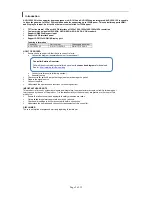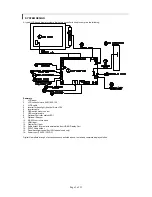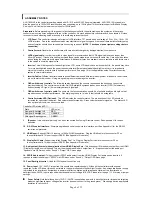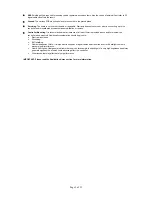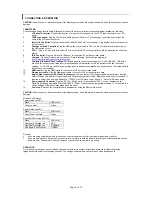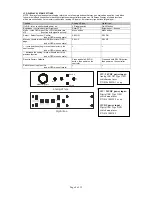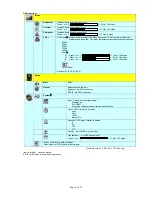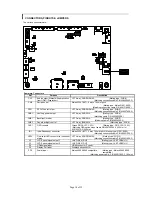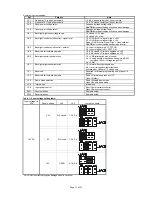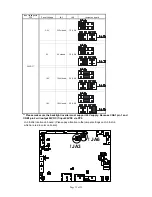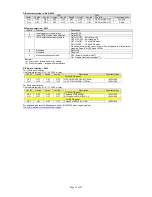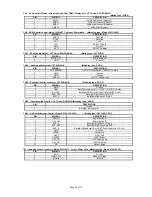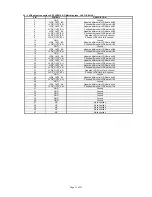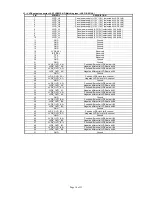
Page 4 of 35
ASSEMBLY NOTES
ALR-1920-120 is the controller board equipped with IE-1010 and ALR-1920 engine integrated. ALR-1920-120 is capable to
drive the panel up to 1920x1200 resolution and also supporting up to 120Hz panel. This controller supports HDMI and Display
Port input. And it will be the lower cost solution for 120Hz panel.
Preparation
: Before proceeding it is important to familiarize yourself with the parts making up the system and the various
connectors, mounting holes and general layout of the controller. As much as possible connectors have been labeled. Guides
to connectors and mounting holes are shown in the following relevant sections.
1.
LCD Panel
: This controller is designed for typical LVDS interface TFT panels with panel voltage 3.3V or 5V or 12V or 18V
LVDS interface. Due to the variation between manufacturers of signal timing and other panel characteristics factory setup
and confirmation should be obtained before connecting to a panel.
(NOTE: Check panel power jumper settings before
connection)
2.
Controller
card:
Handle the controller card with care as static charge may damage electronic components.
3.
LVDS signal cable :
In order to provide a clean signal it is recommended that LVDS signal cables are no longer than
46cm (18 inches). If loose wire cabling is utilized these can be made into a harness with cable ties. Care should be taken
when placing the cables to avoid signal interference. Additionally it may be necessary in some systems to add ferrite cores
to the cables to minimize signal noise.
4.
Inverter
: This will be required for the backlight of an LCD, some LCD panels have an inverter built in. As panels may have
1 or more backlight tubes and the power requirements for different panel models backlights may vary it is important to
match the inverter in order to obtain optimum performance. See page 19 for the Application notes “Inverter connection
section for more informations.
5.
Inverter Cables
: Different inverter models require different cables and different pin assignment. Make sure correct cable
pin out to match the inverter. Using wrong cable pin out may damage the inverter.
6.
OSD switch mount controls
: The following section discusses the controls required and the section on connectors
provides the detail. The controls are minimal: On/Off, Backlight Brightness (depends on inverter), OSD (5 momentary
buttons) analog VR type or (8 momentary buttons) digital type.
7.
OSD switch mount controls cable
: The cables to the function switches should be of suitable quality and length so that
impedance does not affect performance. Generally lengths up to 1 metre (3 feet) should be acceptable.
8.
Controller status LED (Optional)
: This LED indicates the controller status. The pin direction of the LED should be
corrected for right colour indication. Red colour stands for standby. Green colours stands for signal on. The status LED
is an optional part only, can be unconnected.
Controller LED status (LED1) :
State LED
color
No signal & backlight off
RED
No signal & backlight on
ORANGE
With signal & backlight on
GREEN
9.
IR
sensor
: It is an optional part only, can be unconnected if not using IR remote control. See Appendix VI for button
definition.
10. RS-232 control interface :
Firmware upgrade and serial control via this interface port. See Appendix II for the RS-232
serial control protocols.
11. HDMI input :
Support HDMI 1.3 input up to 1080p/WUXGA resolution.
Plug the HDMI cable to the connector P3 on
the controller board. This port support DDC/CI (See Appendix III in details).
12. Display Port Cable :
Support single-link Display Port 1.1a. Plug the Display Port cable to the connector P4 on
the controller board. This port support DDC/CI (See Appendix III in details).
13. Audio output (Stereo) with amplication from HDMI / Display Port :
This port support Stereo audio output from the HDMI
/ Display Port audio source inputted. This port has the same audio path output from J1. It requires to select the audio port
“Speakers” via OSD menu under “Sound” > “Output” OSD menu page.
14. SPDIF Audio output :
This port support SPDIF audio output from the HDMI / Display Port audio source inputted. It
requires to select the audio port “SPDIF” via OSD menu under “Sound” > “Output” OSD menu page.
15. Panel Backlight control :
Used for 120Hz panel connection only.
16. Power Input
: 12V / 24V DC is required, this should be a regulated supply. Although the controller provides power
regulation for the LCD power this does not relate to the power supplied to the backlight inverter. If an unregulated power supply
is provided to an inverter any fluctuations in power may affect operation, performance and lifetime of the inverter and or
backlight tubes. 24VDC input is required when the panel output voltage is 18VDC. Please refer to page 11-12 for proper jumper
settings.
•
Power
Safety
: Note that although only 12VDC / 24VDC is supplied as ‘power-in’ a backlight inverter for panel backlighting
produces significantly higher voltages (the inverter does not connect to the ground plane). We strongly advise appropriate
insulation for all circuitry.


